This is a Zeiss-Ikon Ikonette, a 35mm scale focus camera produced by Zeiss-Ikon AG in Stuttgart, West Germany starting in November 1958. The Ikonette is a uniquely styled camera with an attractive curved light gray body that was primarily marketed as a lady’s camera. It was thought that by giving the camera an attractive design with curved edges and simple operation, women would be more inclined to buy them. Unfortunate as that may be, the camera does have a very distinct shape that could be appealing to collectors today for a different reason. The camera has a unique film advance lever which doubles as the shutter release, and an in body recessed rewind knob under the top plate. Whether it be due to poor marketing, or a shape that didn’t connect with anyone, the Ikonette was not produced for very long and is an uncommon camera today.
Film Type: 135 (35mm)
Lens: 45mm f/3.5 Novar-Anastigmat coated 3-elements in 2-groups
Focus: 0.9 meters to Infinity
Viewfinder: Scale Focus with Shutter Readiness Indicator
Shutter: Pronto Leaf
Speeds: B, 1/30 – 1/250 seconds
Exposure Meter: None
Battery: None
Flash Mount: Cold shoe and ASA Flash Sync Port
Other Features: Self-Timer
Weight: 416 grams
Manual: https://www.cameramanuals.org/zeiss_ikon/zeiss_ikon_ikonette.pdf
How these ratings work |
The Zeiss-Ikon Ikonette is a beautifully designed camera with a curved gray body with a simplified operation that was thought would make it more appealing to women. Featuring a unique combined film advance and shutter release lever, the camera takes a bit of getting used to, but with its excellent Novar-Anastigmat triplet lens, is capable of really terrific images, as long as you can get around its many drawbacks. | ||||||
| Images | Handling | Features | Viewfinder | Feel & Beauty | History | Age | |
| 1 | 1 | 1 | 1 | 2 | 1 | 30% | |
| Bonus | none | ||||||
| Final Score | 9.1 | ||||||
History

The Zeiss-Ikon Ikonette is an attractive and curiously designed camera that upon its release, was marketed as a “lady’s camera”. It came in a unique gray body with soft curves, and had simple controls which were thought to be easier for women to hold and understand. It is a camera which could never be made today.
In the era it was made, attitudes towards gender roles were a lot different than they are now. For many in the mid 20th century, there were certain expectations of what people should and shouldn’t be able to do depending on their gender, and there was a whole industry of products made specifically for men and some for women.
In photography, there certainly wasn’t anything about a Leica or Nikon that made it so only a man could use it and a woman couldn’t, but there was a pervasive thought that “real cameras” were for men, and if a woman wanted to make her own pictures, then she automatically needed something simpler, and more appealing to her feminine sensibilities.
Of course this is nonsense, but the world was a lot different back then, and in the late 1950s, Zeiss-Ikon AG Stuttgart created the Ikonette for women. It had a three element Novar-Anastigmat lens, a four speed Pronto leaf shutter, and scale focus. Functionally, the only thing that allowed the Ikonette to stand apart from other cameras with similar specifications was a large lever to the side of the shutter, in easy reach of the photographer’s right index finger that was used for both film advance and firing the shutter. One press down advanced the film and cocked the shutter, and then a second fired the shutter. Easy enough for a woman, they thought.

In Zeiss-Ikon’s defense, they were not the only company who thought this way. In fact, the idea of designing a camera for women goes back as far as the start of the 20th century when the in 1906, the German camera maker Certo created the Damen-Camera, a simple model which folded into a lyre shaped leather case resembling a ladies purse. The folded camera was covered in an alligator skin like leather and was decorated with a shiny metal carrying chain and other ornate pieces of jewelry.

In the early 1960s, a very unfortunate camera called the Fotron was produced and marketed towards housewives by a company called the Traid Corporation. The Fotron is considered by many to be one of the worst cameras ever made for more reasons than how it was marketed, however. It was an ugly behemoth of a camera with poor features, poor image quality, and a sky high price tag that was largely sold door to door to unsuspecting housewives for exorbitant prices.
When it was advertised, Traid claimed that it was “Ideal for the 99 out of 100 wives who refuse to fuss with their husbands’ cameras.”
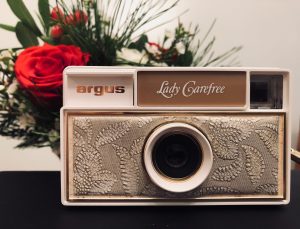
In 1967, Argus released the Lady Carefree, an extremely simple plastic camera made of white plastic and decorated with gold foil accents and covered in a soft paisley pattern resembling a lady’s purse. Two additional models called the Lady Carefree Elite and Debutante rounded out this misguided family of cheap cameras.
Even as recently as 1979, Nikon released the Nikon EM, which at the time was the company’s smallest SLR. It was sold as a camera designed for women with a simpler operation and a smaller body with ergonomics designed specifically for those with smaller hands.
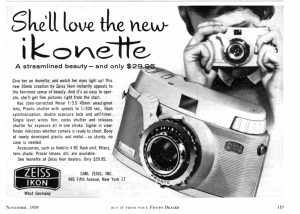
So in 1958 when the Ikonette first went on sale, marketing it as “the ideal model for the fashion-conscious woman”, no one batted an eye. The advertisement to the right suggests that “she’ll love the new Ikonette” and to “watch her eyes light up” at the camera’s streamlined and beautiful package.
Perhaps the most unfortunate thing about how the Ikonette was advertised is that it was a pretty neat camera with looks that differentiated itself from the countless number of similar scale focus cameras. There simply was no reason to advertise it as a camera for women as I think it could have been a good seller if it was simply sold as a new type of simple camera.
People might have liked the neat film advance which allowed one handed operation without ever having to reposition your hand between firing the shutter and advancing to the next frame. The body was made out of “a new type of plastic material” that was said to be very rugged and immune to changes in temperature. Although I could not find any specifics to what the body was made of, to me it feels like regular Polyethylene plastic, which at the time would have been a big improvement from Bakelite which was fragile and could crack easily when dropped.
Each of the four pages below come from various Zeiss-Ikon dealer catalogs, courtesy of Pacific Rim’s Reference Library.
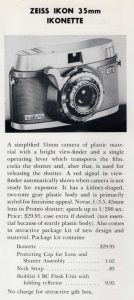
The Ikonette was exported to the United States, but I could not find any information about it being sold elsewhere, suggesting this was an exclusive American market camera. Whether that’s true or not, Zeiss-Ikon dealer pages listed the camera with a retail price of $29.95 with an optional ever ready case for $6.50 more. A second outfit which included an accessory flash, protective cap, neck strap, and the camera cost $42.40. All three prices, when adjusted for inflation, compare to around $305, $65, and $435 today, certainly on par with other inexpensive entry level cameras.
I could not find any contemporary review or product mention for the Ikonette in any photographic publication that I had access to. There is a very high chance that its status as a “women’s camera” was the reason for that, as the major publications likely wouldn’t have thought their readers (i.e. men) would be interested in it.
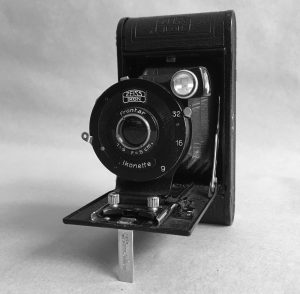
Fun Fact: When Zeiss-Ikon chose the name Ikonette for this camera, it was the second time that name had been used. The first, was in 1928 on the Ikonette 504/12, a compact folding camera that used 127 format roll film. The Ikonette is also noteworthy as the first all new design sold after the Zeiss-Ikon merger that happened in 1926. Prior to the Ikonette, all Zeiss-Ikon cameras were rebadges of existing models built by the companies that preceded it.
The Ikonette appears to have only been produced for a little over a year as it was officially discontinued in October 1960. A persistent rumor on the Internet is that Zeiss-Ikon recalled the camera as many had light leaks, possibly caused by their use of a light colored plastic for the body. Although many sites online make this same claim, I was unable to find any mention of it from the era in which it occurred.
If true, this would further suggest these cameras are hard to find today. Not many were sold and of the ones that were, an unknown were taken back by the factory and destroyed. As I write this, 8 were for sale on eBay Worldwide.
Today, the Zeiss-Ikon Ikonette is an uncommon curiosity. Whether you are aware of how it was marketed, simply seeing one on a shelf makes it look different than other cameras, and for that, many collectors like to have one on their shelf. For anyone interested in putting a roll of film through it, its got a Zeiss lens, so it should be capable of pretty nice shots, and with unique ergonomics and an interesting design for the film advance and shutter release, I suspect this camera has a lot of appeal to many people.
My Thoughts
When it comes time to decide which cameras I want to review on this site, I generally look for something that’s different, interesting, or unique about a specific model. Maybe it is a rare camera that people are not likely to see, or a camera that pioneered for the first time a feature that we take for granted today, or perhaps there’s just something interesting about the camera itself, its development, or the people who created which would make for an interesting review.
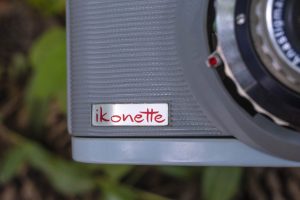
In the case of the Zeiss-Ikon Ikonette, there were a couple of things that jumped out to me. For starters, the pretty bluish gray body is very striking. I’ve only ever come across one other blue camera before, the appropriately named Bilora Bella 3c which I reviewed some time ago for similar reasons.
Is it Blue or is it Gray? In an early draft of this review, I referred to the Ikonette as having a blue body. After all, it looks blue, both in the pictures in this review and in person. However, all period documentation and some online photos suggest it is gray. Is it possible that depending on the light, the gray plastic can take on a blue color, or that over time the plastic itself changes color, developing a bluish hue? I do not have the answers to these question, only than to say, it looks blue to me!
Second, is the interesting implementation of the combined film advance and shutter release. I’ve shot many cameras like the Zeiss-Ikon Tenax II and Konica III which advance the film with the front mounted lever and I’ve shot plenty that have front lever shutter releases, but the Ikonette is unique in that a single lever does both.
Finally, there’s the whole “designed for women” aspect. Again, it is not entirely unusual for there to be a mid 20th century product designed for a specific gender, but the whole package together, combined with the history of how the camera was advertised made it an easy decision for me to want to review it.
The Zeiss-Ikon Ikonette weighs a reasonable 416 grams excluding the case and with no film in it. The camera is neither too light nor too heavy, however the soft edges of its kidney bean shaped body mask its weight to where it actually feels lighter than it really is. Strangely, for a camera designed for women, I found the ergonomics of the camera’s controls to perfectly fit my average sized male hands. If I was a designer aiming for a camera with more dainty proportions, I am not sure the Ikonette would have hit its target goals.
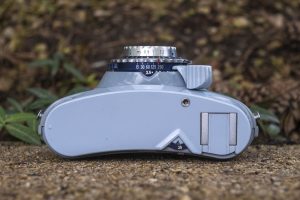
Up top, the Ikonette has one of the cleanest designs you’ll ever see on a 35mm camera. The entire left side is entirely blank, almost too blank, like if there was supposed to be a camera logo imprinted here, but someone forgot it. Off to the right is the manually resetting exposure counter, a threaded cable release socket and an accessory shoe, partially covered by a spring loaded plate that pops up to fill the middle void when nothing is attached to it.
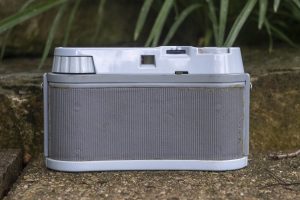
Around back, we see the film rewind knob sticking out from around the edge of the top plate. This design for the knob means you cannot grip it in its entirety, but rather need to spin it with several short motions, which I find to be rather inconvenient. A similar design was used on the short lived American Vokar rangefinder from the 1930s.
In the center is the small rectangular opening for the viewfinder, and to its right both the back edge of the exposure counter, and beneath it, a slider which is used to deactivate the film transport for rewinding film back into its cassette.
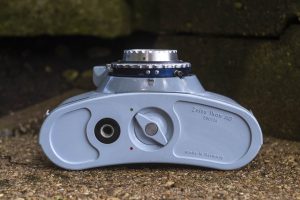
The bottom of the camera is almost as bare as the top, with a slightly offset 1/4″ tripod socket, and a twisting lock for the film compartment. Two small dots, one green and one red, are used to indicate open and closed. In a recessed area off to the right are the words, “Zeiss-Ikon AG 500/24” and “Made in Germany”, just in case you forgot!

The sides of the Ikonette are symmetrical with no differences to see. As the entire camera back comes off to access the film compartment, there is no hinge or sliding lock to see. On the front edge of both sides of the camera is a metal post for attaching a special type of neck strap. I prefer standard strap loops as they’re more universal as if you were to lose the original strap that came with this model, finding a replacement can be a challenge. Also note from the right side of the camera, you get a good look at the combined film advance and shutter release.

Removing the back is as simple as turning the lock to the green position and sliding the back off. The back of the camera and its bottom are one single piece, which when removed, means the camera cannot be placed on a flat surface easily. Film transports from left to right onto a slotted fixed take up spool. Simply thread the film into the slot, making sure the single tooth catches a perforation, advance the film a couple of times to make sure it is secure and reattach the back.
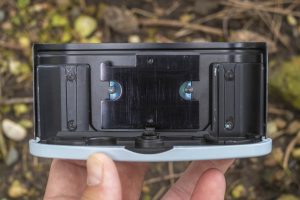
The inside of the back is an oddly shaped metal pressure plate. The strange shape of the plate is there to make room for the rivets that attach it to the camera’s curved back, along with a notch to make room for the perforation gear. Although the camera body is curved, the film plane is flat, unlike cheaper cameras with meniscus or doublet lenses.
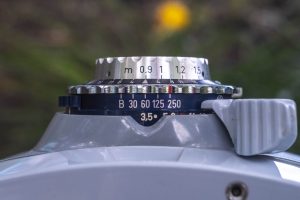
Looking down upon the Pronto leaf shutter, we see typical settings for shutter speed and aperture, along with the focus scale engraved into the outer edge of the front element. The selection of speeds is small, only offering four speeds from 1/30 to 1/250 plus Bulb. The diaphragm is controlled by moving a plastic tab around the perimeter of the shutter, showing only the chosen f/stops in a curved indentation in the plastic. Not visible in the image to the right is a small self timer lever which sticks out at the 9 o’clock position around the lens.
Without a doubt, the second most striking aspect of the camera’s design is the large paddle lever on the side of the shutter, which is actuated by the photographer’s right finger. The concept is quite simple, with two quick presses of your finger, you can both advance the film and cock the shutter, and then fire the shutter, all with the same finger, and without having to change the position of your hands. The Ikonette’s manual cautions you from obstructing the film rewind knob while advancing the film as it can cause transport problems or damage the film.

To help remind people which of the two functions of the lever will happen the next time you press it, a vertical red marker will appear in the viewfinder when the shutter is not set. With this marker set, pressing the lever advances the film, cocks the shutter, and then makes the marker disappear. A second press of the lever fires the shutter and makes the red marker return. This alternating pattern of advance, fire, advance, fire is easy to remember with quick back to back shots, but sometimes can get confusing if you set the camera down for an extended period of time.
The rest of the viewfinder is very basic, showing no exposure information or any sort of frame lines. The entire visible window frames the 45mm image. Although small, I had no problem seeing the entire viewfinder while wearing prescription glasses.
And that’s it! This is a simple camera with few controls. There is no metering, no flash synchronization, and no other confusing controls for wome….err, I mean novices to struggle with!
Overall, the Zeiss-Ikon Ikonette is a curious blend of an attractive curved body, a unique combined film advance shutter release lever, and a lens and a rather simple lens and shutter combination. Thinking back to the idea that it is a camera marketed specifically towards women, beyond its cosmetic appearances, I don’t see a lot here that differentiates it from one of a zillion other simple scale focus cameras from the 1950s and 60s. Of course things could change after I load in some film and shoot it. If you’re curious how that turned out, keep reading!
My Results
For my test roll of film through the Ikonette, I tried a fresh roll of Fuji 200. In my tests playing with the camera, I had some concerns about the shutter. Using the film advance lever as the shutter release is a bit unorthodox and the process felt “janky”. After a few dozen test fires, it seemed to be working good enough so I took it with me to work for a few days and captured some shots on my commute.
Starting with the most obvious which is that the camera has some light leaks causing vertical white strips on several images. Normally, whenever you see a light leak like this, it is most likely the door seal causing it, but when using color film like Fuji 200, the light travels through the back of the emulsion giving you reddish orange leaks on the film. In this case, the leaks are all white, suggesting the leak is coming from in front of the film plane. This possibly confirms the rumor mentioned in the History section above that soon after the Ikonette’s introduction, Zeiss-Ikon recalled all models due to light leaks. Were these light leaks characteristic of all cameras that were part of the recall, or is this something that has happened to this example over the 60+ years since it was made? I cannot be certain.
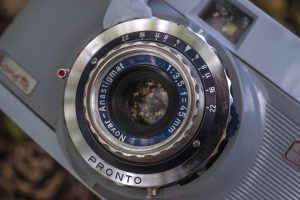
Beyond the leaks however, there is still enough to see what look to be pretty decent images. Despite the relative simplicity of the camera, it does have a Zeiss lens on it, and Carl Zeiss was no stranger to making good lenses, even if they only had three elements. The 45mm f/3.5 Novar-Anastigmat lens rendered sharp images with even coverage corner to corner. Color accuracy was spot on, especially in interior light like in the mirror selfie. A tiny amount of softness exists around the edges, but nothing that would have offended the target market or price point the camera would have sold at.
The shutter did its job, as a shutter should, and although the camera is limited to only four speeds, at least they are the most useful speeds to have, where shooting ASA 50 – 200 speed films should cause no issues.
Shooting the camera was a mostly pleasant experience. Although the viewfinder is small, I had no problem seeing the entire image, even while wearing prescription glasses, and since there is no rangefinder or need for a beamsplitter, the image was very bright.

The curved body was comfortable to hold it and it fit my hands perfectly, suggesting that someone with smaller hands might have struggled to use it, which is strange as this was supposedly a camera designed with women in mind.
The sleek design of the rewind knob looks great, but functions poorly. Since you can only grip it through a little more than 180 degrees of a rotation, and only on the sides, you have to make many small motions with your fingers to completely rewind the film. Thankfully my test roll only had 24 exposures, but had I used a 36 exposure roll, it would have taken me a very long time and tired out my fingers to rewind it fully. While I applaud a sleek camera design, it should not come at the expense of functionality, which this very much does.
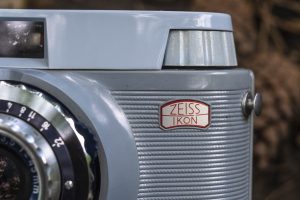
Even though it was meant to be easy to use, I didn’t particularly love the film advance/shutter release combination as the operation felt jarring and unexpected when I was using the camera. A complete motion takes quite a bit of movement, which for me, wasn’t an issue, but is another area where someone with smaller fingers might have struggled.
The motion of the film advance feels much different than that of the shutter release, but I found a few times where pressing the lever all the way down would cause it not to return, somewhat jamming the shutter. When this happened, I had to press it with a bit more force to get it to return to its original position, but doing so would usually cause the shutter to fire, possibly suggesting this camera needs some service. The whole process is not smooth, and there were many instances where I wasn’t even sure the shutter was firing. The image in the gallery above where you can see a blurred image of half my head is a direct result of this.
Combine this in a camera that was reportedly recalled by its manufacturer for light leaks…which I got, and you have yourself a pretty miserable camera. With the benefit of hindsight today, marketing a camera specifically for women doesn’t make a lot of sense, but that could be forgiven in 1958. But poor ergonomics, a design that likely didn’t comfortably fit the hands of its target customer, a poorly designed rewind knob, and a body that is prone to light leakage take a misguided camera and turn it into a complete disaster.
The Zeiss-Ikon Ikonette is certainly a camera from a bygone era. It looks great on a shelf, and when all things work in its favor, it does make nice images, but compared to a huge number of similar cameras from the same era, this is a camera that definitely deserves a spot in the history books, but not in your camera bag.
Related Posts You Might Enjoy
External Links
https://camerapedia.fandom.com/wiki/Ikonette_35
https://vintagecameralab.com/zeiss-ikon-ikonette/
http://elekm.net/pages/cameras/ikonette.htm
https://www.pacificrimcamera.com/pp/ziikonette35.htm
https://www.photo.net/discuss/threads/a-class-act.496696/
https://www.collection-appareils.fr/x/html/appareil-5412-Zeiss%20Ikon_Ikonette%20.html

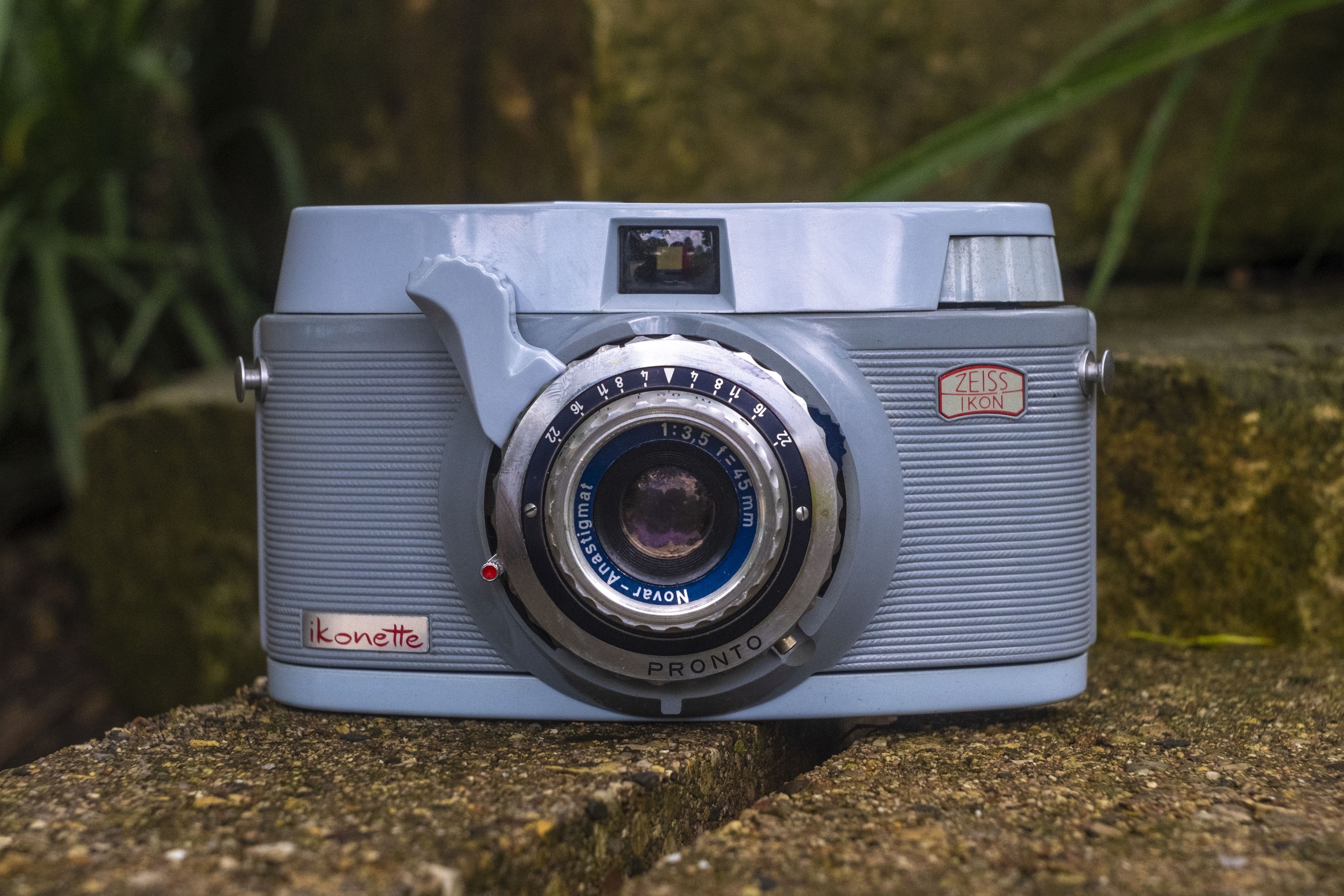
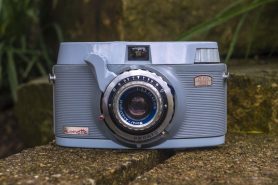
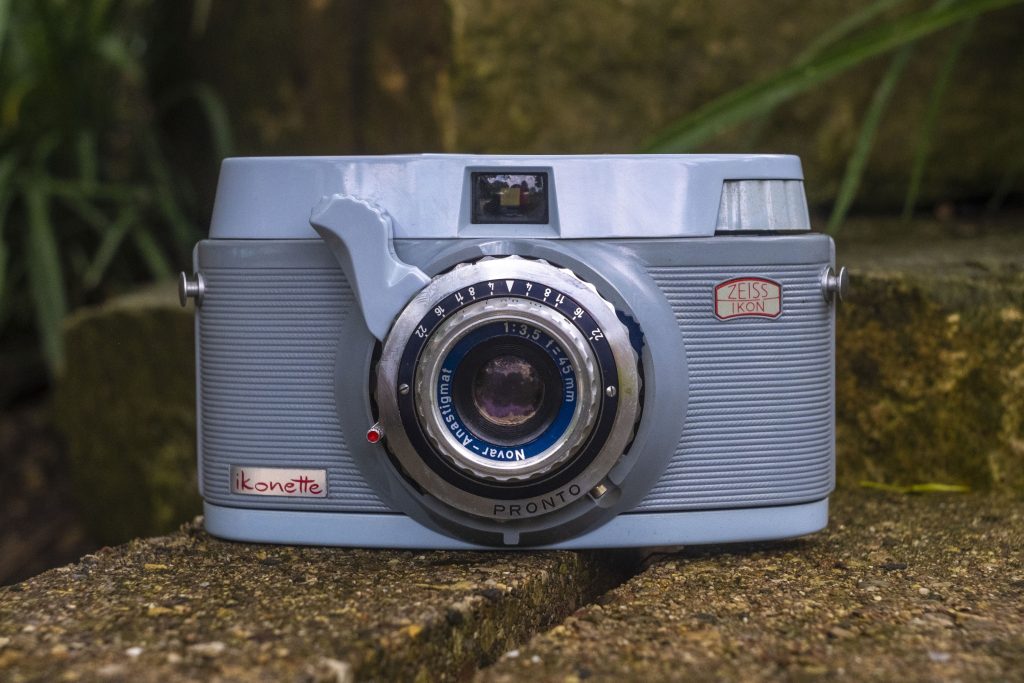
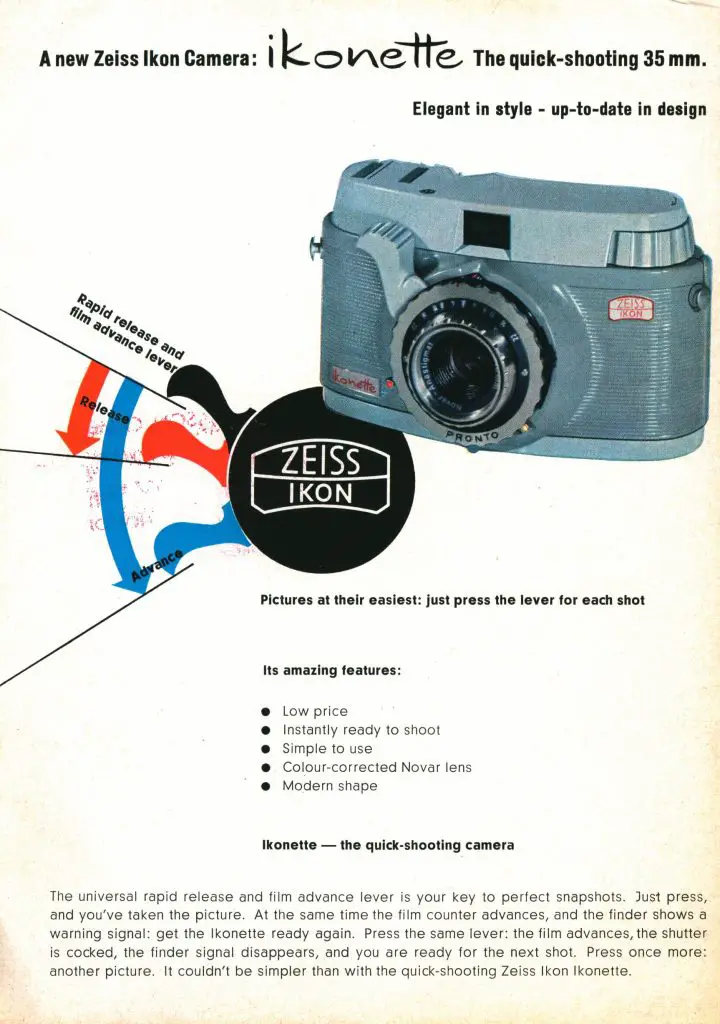
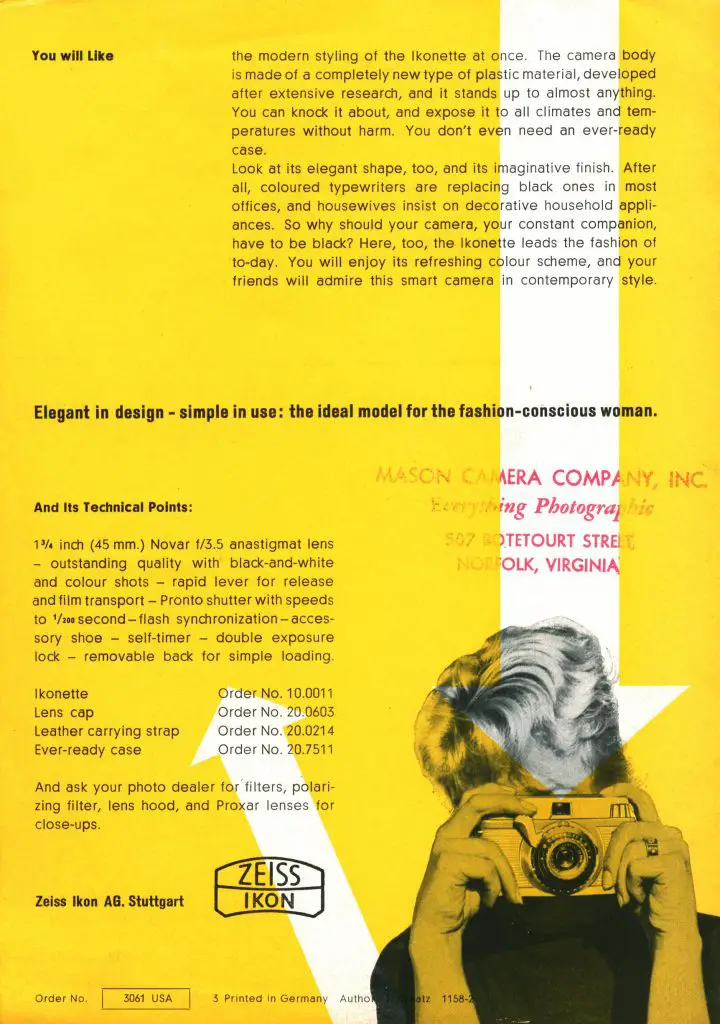
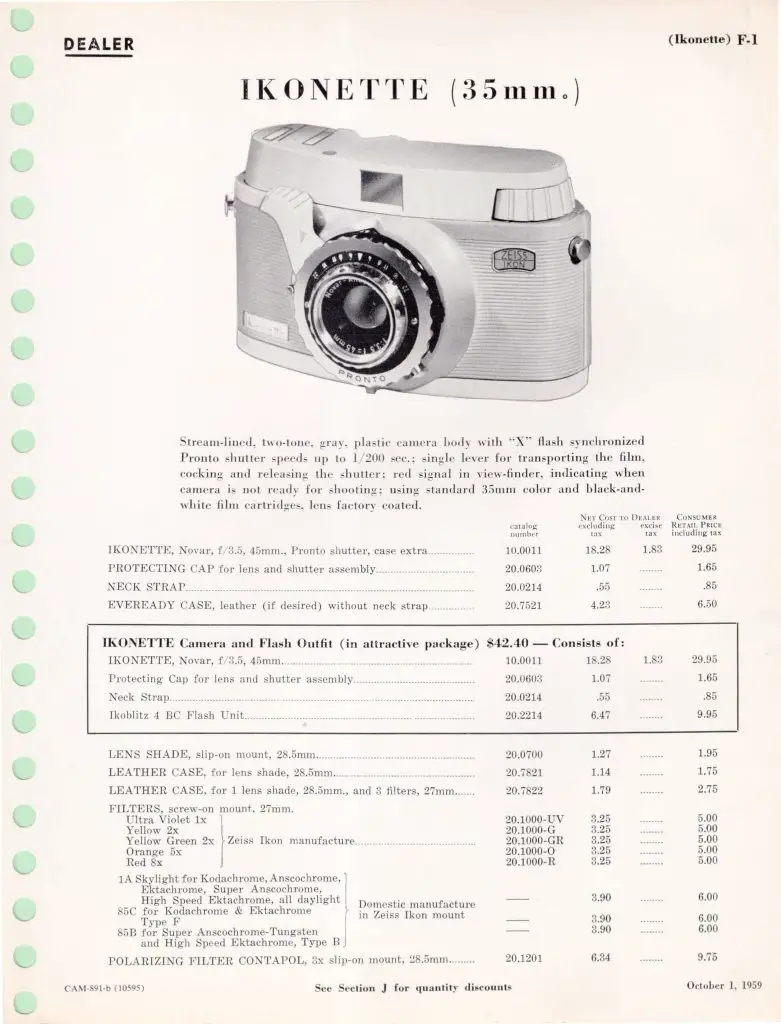
















Superb review Spot on.
Glad you liked it and thank you for letting me borrow it. This isn’t a camera I otherwise would have ever sought out on my own.
An interesting design, and even more so when seen from below with its curved (banana shaped?) body, which I’ve never seen shown before, so this came as a surprise. And it has a very decently performing lens in the Novar, as you demonstrate.
But I have to disappoint you, Mike, it’s 4-in-1 lever action to wind film, set shutter, advance frame counter and fire shutter is not unique. My Agilux Agimatic does this, too. And given its production run from around 1956 to 1959 (some sources only quote 1958, which is clearly incorrect) it pre-dates the Ikonette.
My Adox 300 has a similarly styled lever but checking it now for these comments, I’d overlooked that it has a conventional shutter release. In this case it emulates the collar advance of the Werra Models, but uses a lever.